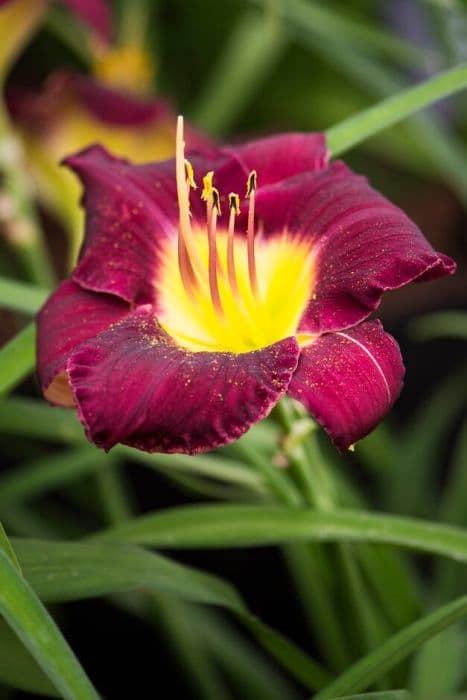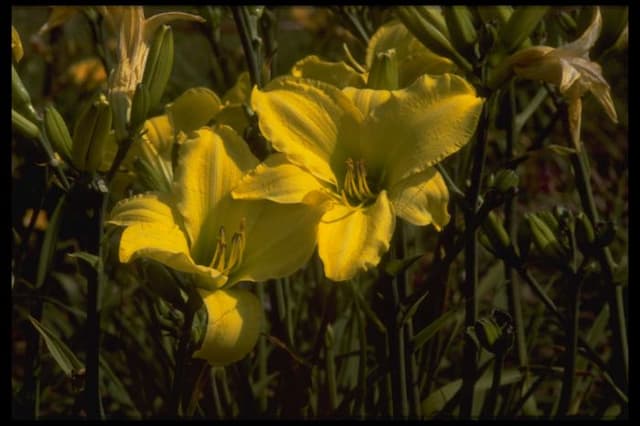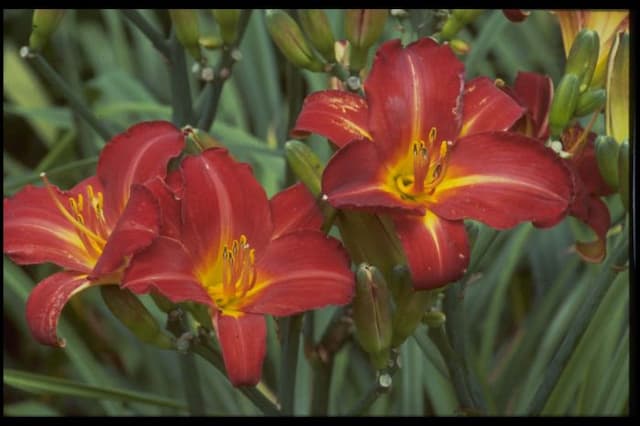Daylily Hemerocallis 'Chief Sarcoxie'

ABOUT
The Hemerocallis 'Chief Sarcoxie', commonly known as the daylily, sports a vibrant display that captivates the eye. The striking feature of this plant is its alluring flowers, which exude a regal presence with a luscious deep red hue. The blossoms are characterized by a trumpet shape which unfurls from a tightly swirled bud, revealing petals that sometimes display a slightly ruffled edge, adding to their charm and elegance. In the throat of the bloom, a golden-yellow to greenish tone can often be detected, creating a stunning contrast that enhances the richness of the red petals. The flowers sit atop sturdy, long, and slender stalks known as scapes, which elegantly arch above a dense clump of foliage. The leaves of the daylily are long and strappy, presenting a lush green color that forms an attractive fountain-like mound. The foliage provides a perfect backdrop to the exquisite blossoms and highlights their beauty even more. Each flower of the 'Chief Sarcoxie' typically only lasts for a single day, opening up with the morning light and withering as the day ends. However, due to the abundance of buds that this plant produces, the blooming period can extend over several weeks, providing a prolonged display of splendor. The dynamic appearance of this daylily variant makes it a popular choice for gardeners looking for an eye-catching and low-maintenance perennial that can add a touch of elegance and a pop of color to their garden beds or borders.
About this plant
 Names
NamesFamily
Asphodelaceae
Synonyms
Daylily
Common names
Hemerocallis 'Chief Sarcoxie'.
 Toxicity
ToxicityTo humans
Hemerocallis 'Chief Sarcoxie' is also known as the daylily. Daylilies are generally not considered toxic to humans, and some parts of the plants are even edible when correctly identified and prepared. It is crucial to know that not all parts of the plant are edible, and one should always consult an expert before consuming any part of it, as misidentification with toxic lilies could lead to serious health issues. However, for the daylily, there are no widely recognized toxic effects in humans from consuming this plant, when correctly identified and prepared.
To pets
The daylily is considered highly toxic to cats. If a cat ingests any part of a daylily, it can lead to acute kidney failure. Symptoms of poisoning in cats may include vomiting, lethargy, lack of appetite, dehydration, and changes in urination. It's essential to seek veterinary care immediately if there is suspicion that a cat has ingested daylilies. For dogs and other pets, the daylily is generally not considered toxic, but ingestion can sometimes result in mild gastrointestinal upset. Owners should still be cautious and prevent pets from consuming plants.
 Characteristics
CharacteristicsLife cycle
Perennials
Foliage type
Deciduous
Color of leaves
Green
Flower color
Red
Height
2 feet [60 cm]
Spread
18 inches [45 cm]
Plant type
Herb
Hardiness zones
3
Native area
Asia
Benefits
 General Benefits
General Benefits- Easy to Grow: The Chief Sarcoxie daylily is known for its hardiness and its ability to thrive in a variety of conditions, making it a low-maintenance choice for gardeners.
- Attractive Flowers: It produces striking, large yellow flowers that add a splash of color to any garden.
- Drought Tolerant: Once established, it can tolerate periods of drought, which can be beneficial in regions with water restrictions or low rainfall.
- Pest Resistant: It is generally resistant to many pests and diseases, reducing the need for chemical treatments.
- Soil Improvement: Like other daylilies, it can help with soil erosion control due to its root system, and it can improve the overall soil condition over time.
- Wildlife Attraction: The flowers can attract pollinators such as bees and butterflies, supporting the local ecosystem.
- Versatile Landscaping: The plant can be used for various landscaping purposes, such as in flower beds, borders, or as ground cover.
- Long Blooming Period: The Chief Sarcoxie can bloom for several weeks, providing long-lasting visual interest.
 Medical Properties
Medical PropertiesThis plant is not used for medical purposes.
 Air-purifying Qualities
Air-purifying QualitiesThis plant is not specifically known for air purifying qualities.
 Other Uses
Other Uses- Edible flowers: The blooms of the daylily can be eaten raw in salads, or cooked in various dishes.
- Natural dye: The petals of daylilies, particularly the darker varieties, can be used to produce a natural dye for fabrics or crafts.
- Companion planting: Daylilies can be planted alongside vegetables such as tomatoes to provide ground cover and deter certain pests.
- Livestock feed: In some cultures, daylily leaves and shoots are used as fodder for livestock, especially pigs and goats.
- Erosion control: The sturdy root system of daylilies makes them excellent plants for stabilizing soil and preventing erosion on slopes.
- Fish poisoning: Historically, some cultures have used the toxic substances found in certain daylilies to stun fish, making them easier to catch.
- Garden structure: The tall and robust foliage of daylilies adds structure to garden beds, providing a backdrop for lower-growing plants.
- Water purification: Daylilies can be grown in aquatic environments, where they can help absorb nutrients and reduce algae growth in ponds.
- Biomonitoring: Daylilies could potentially serve as bioindicator plants, their health reflecting the quality of the environment in which they grow.
- Arts and crafts: Dried daylily flowers and seed pods can be used in floral arrangements or as components in art projects.
Interesting Facts
 Feng Shui
Feng ShuiThe Daylily is not used in Feng Shui practice.
 Zodiac Sign Compitability
Zodiac Sign CompitabilityThe Daylily is not used in astrology practice.
 Plant Symbolism
Plant Symbolism- Daylily (Hemerocallis 'Chief Sarcoxie')
- Beauty: Daylilies are appreciated for their vibrant, often multicolored flowers, symbolizing natural beauty and grace.
- Motherhood: In Chinese culture, daylilies represent motherhood and parental devotion, because the plant's ability to produce numerous buds is associated with the nurturing aspects of mothers.
- Transience: The name "daylily" comes from the Greek words "hemera" (day) and "kalos" (beautiful), referring to the flowers' short bloom time, which symbolizes the fleeting nature of life.
- Forgiveness: Due to their daily renewal cycle, with each bloom lasting only a day, daylilies are also symbolic of forgiveness and forgetting past grudges, representing new beginnings and fresh starts.
- Longevity: The perennial nature of daylilies, which can survive with minimal care, symbolizes endurance and the ability to thrive through challenges.
 Water
WaterDaylilies, like the Hemerocallis 'Chief Sarcoxie', prefer to be watered deeply and infrequently rather than little and often. Aim to water them every 7 to 10 days, providing about one inch of water each time, which is roughly 0.623 gallons per square foot. During the hotter and drier months, increase the frequency to ensure the soil remains evenly moist but not waterlogged. In cooler and wetter periods, reduce the frequency accordingly. Consistent watering is especially important during the blooming period to encourage healthy, vibrant flowers. Use a soaker hose or drip irrigation to deliver water directly to the roots, minimizing evaporation and preventing water from sitting on the foliage, which can lead to disease.
 Light
LightDaylilies, such as the Hemerocallis 'Chief Sarcoxie', thrive best in full sun to partial shade. They should receive at least six hours of sunlight daily; however, in extremely hot climates, some afternoon shade can help to protect the plants from scorch. An ideal spot for daylilies is one where they can bask in the morning sun but are shielded from the intense afternoon heat. This ensures they get the light they need without being stressed by excessive temperatures.
 Temperature
TemperatureDaylilies, including Hemerocallis 'Chief Sarcoxie', are quite adaptable and can survive in a broad range of temperatures. They can tolerate temperatures as low as -30°F to -20°F, making them suitable for many climates. However, for optimal growth, daylilies prefer temperatures between 60°F and 75°F. They enter dormancy over winter and will emerge again in the spring when temperatures are consistently above freezing and the ground has thawed.
 Pruning
PruningFor daylilies such as Hemerocallis 'Chief Sarcoxie', pruning, referred to as deadheading, is done to remove spent flower stalks, which encourages reblooming and maintains plant appearance. After a flower has wilted, cut the stem back to the base of the plant. Throughout the growing season, remove any yellow or brown leaves to keep the plant healthy and attractive. The best time for pruning daylilies is immediately after a flush of blooms have faded, which typically occurs in midsummer.
 Cleaning
CleaningAs needed
 Soil
SoilDaylilies prefer well-drained soil with plenty of organic matter; incorporate compost or peat moss into the mix. Aim for a slightly acidic to neutral pH of 6.0 to 7.0 for optimal growth conditions.
 Repotting
RepottingDaylilies are generally not repotted often as they thrive outdoors; division for propagation or overcrowding is typically done every 3 to 4 years.
 Humidity & Misting
Humidity & MistingDaylilies are not highly sensitive to humidity levels; they are tolerant of a wide range, making them adaptable to various outdoor conditions.
 Suitable locations
Suitable locationsIndoor
Ensure full sun, well-drained soil, and room to grow.
Outdoor
Plant in full sun to partial shade, in well-draining soil.
Hardiness zone
3-9 USDA
 Life cycle
Life cycleThe Daylily 'Chief Sarcoxie' begins its life cycle as a dormant rhizome or root system. After planting, it enters a growth phase where foliage emerges from the crown, producing long, strap-like leaves. As the plant matures, it develops flower scapes which bear multiple buds that bloom into large, colorful, trumpet-shaped flowers, typically in early to mid-summer. Each individual flower lasts only one day, hence the common name Daylily. After flowering, the plant sets seed pods if pollination occurs, although many gardeners remove the spent flowers to encourage reblooming. The plant then either remains semi-evergreen or dies back to the ground in colder climates, to re-emerge the following spring.
 Propogation
PropogationPropogation time
Late Summer to Early Fall
The Hemerocallis 'Chief Sarcoxie', commonly known as the Daylily, is best propagated by division, which should be done in either spring or early fall. To propagate by division, carefully dig up the entire clump of the Daylily, ensuring not to damage the root system. Wash or shake off excess soil so that you can see the individual fans; these are single sections with leaves and roots attached. Use a sharp knife or spade to separate the fans, making sure each division has at least one growing point or crown and several roots. Replant the divisions at the same depth they were growing previously, spacing them approximately 18 to 24 inches apart (about 45 to 60 centimeters), and water them well to establish. This method allows the Daylily to recover quickly and continue growing, producing blooming plants within a year or two.









